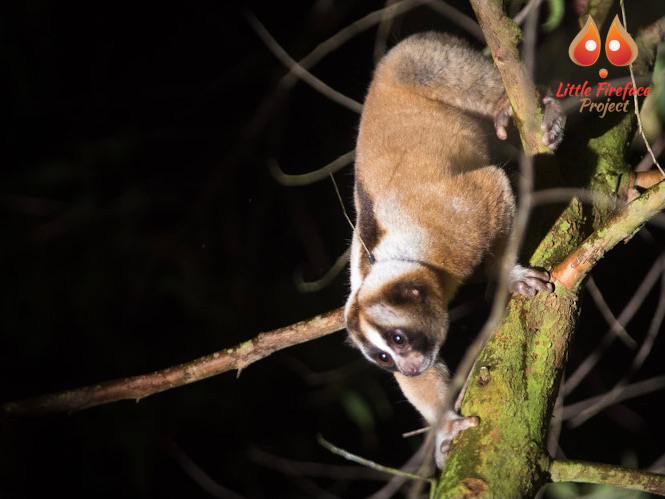Every living thing in this world communicates. In animals, communication usually occurs between the same species, but does not rule out communicating with other species. The form of communication can vary, several forms of communication in animals are ; pheromones (chemicals); auditory cues (sounds); visual cues; and tactile cues (touch)[[1]]. For non-human primates, odours, facial expressions, gestures and vocalisations are often used to inform others about what they feel and what they will do next[[2]]. This includes nocturnal primates, even though it may be hard for us to observe, they are communicating as well, and they have a unique way to communicate with each other!
Form of communication in the Javan slow loris
We know that Javan slow lorises communicate through acoustic and ultrasonic vocalisations. We have identified multiple acoustic vocalisations such as whistle, chitter, squeak, and a unique ultrasonic vocalisation named the “doublet click”. The acoustic vocalisations can indicate different emotions in different contexts, such as chitter in agonistic behaviour or whistle for both agonistic and affiliative interactions. While the doublet click call, is often found during affiliative social interactions[[3]]. But there is other form of communication from this one and only venomous primate that is still little studied, which is scent marking and olfactory searching.
Scent mark can be described as the deposition of odour by defecation, urination or the release of glandular secretions. The scent glands in the Javan slow loris are located on the cheek, chest and genitals, so they will do cheek rub, chest rub or genital rub to transfer their scent to the substrate such as branches or even their mate.
Olfactory searching is the behaviour of detecting odorous substances aerosolized in the environment using their nose. Slow lorises are strepsirrhine primates (meaning “curved nose”), so they have a rhinarium; a moist and naked surface around the nostrils believed to play role in olfaction. The presence of the rhinarium may increase the number of molecules that can be detected because it increases the probability of volatiles being absorbed by the thin layer of mucus that covers the rhinarium[[4]].
That’s just a quick explanation of the scent mark and olfactory search. Interesting isn’t it?

Now, do you think this is important for the lorises? And how this can be classified as communication?
First, it is absolutely important for them! The scent mark has chemical compounds that can inform age, sex, stress, social status, maternal state, group composition, individuality, and its current motivational state[[5]]. This type of communication known as chemical communication. And why is that? There are several hypotheses to why animals scent-mark, from communicating dominance status, attracting or guarding mates, defining their home ranges and defending food sources[5]. This type of communication can inform many things through the distance, day or night and through different types of habitat, whereas usually vocalisations can only be used for communication at short distances[[6]].
Now for example, imagine you are a loris, and when you are sniffing around, you come across an new or unusual odour in your territory. You can tell that you have an intruder, right? You can climb through the trees and search for the intruder and defend your family. Or when you are foraging or dispersing – trying to find your own home range, then you sniff the branches and your brain tells you that “this is an old female’s home range and she is in oestrus”, you can decide whether you want to fight this female and take her territory, or you choose to find another area. Another example is; you are a young loris, and you are hungry. You have been taught to gouge the tree bark to eat the gum. Then you wake up from your sleeping site and follow the odour that your mama marked on the tree branches. You sniff and sniff until you smell the nice gum from the tree bark. You start gouging and now you can eat until you’re full! This is the type of communication that cannot be done vocally if you are quite far from your mama.
In conclusion,
From this little explanation, we have shown that the social communication in the Javan slow loris is complex. This means that even though they are small, active at night, often seem to be alone, that doesn’t mean that they are solitary animals. They are very social, it’s just a different type of social interaction that we need to look closely to understand. Also, maybe it is not familiar to see the communication through the scent mark and olfactory search for such a small nocturnal primate, but hey the Javan slow loris uses that! And when they sniff the odour, they will know if you are family or foe.
Setiap makhluk hidup di dunia ini berkomunikasi. Pada hewan, komunikasi biasanya terjadi antara spesies yang sama, tetapi tidak menutup kemungkinan berkomunikasi dengan spesies lain. Bentuk komunikasi bisa bermacam-macam, beberapa bentuk komunikasi pada hewan adalah ; feromon (bahan kimia); isyarat pendengaran (suara); isyarat visual; dan isyarat taktil (sentuhan)[ ]. Untuk primata non-manusia, bau, ekspresi wajah, gerak tubuh dan vokalisasi sering digunakan untuk memberi tahu orang lain tentang apa yang mereka rasakan dan apa yang akan mereka lakukan selanjutnya[ ]. Ini termasuk primata nokturnal, meskipun mungkin sulit untuk kita amati, mereka juga berkomunikasi, dan mereka memiliki cara unik untuk berkomunikasi satu sama lain!
Bentuk komunikasi pada kukang jawa
Kita tahu bahwa kukang jawa berkomunikasi melalui vokalisasi akustik dan ultrasonik. Kami telah mengidentifikasi beberapa vokalisasi akustik seperti peluit, chitter, squeak, dan vokalisasi ultrasonik unik bernama “doublet click”. Vokalisasi akustik dapat menunjukkan emosi yang berbeda dalam konteks yang berbeda, seperti chitter dalam perilaku agonistik atau bersiul untuk interaksi agonistik dan afiliatif. Sedangkan panggilan klik ganda, sering ditemukan pada saat interaksi sosial afiliatif[ ]. Namun ada bentuk komunikasi lain dari satu-satunya primata berbisa ini yang masih sedikit dipelajari, yaitu penandaan aroma dan pencarian penciuman.
Tanda aroma dapat digambarkan sebagai pengendapan bau oleh buang air besar, buang air kecil atau pelepasan sekresi kelenjar. Kelenjar bau pada kukang terletak di pipi, dada dan alat kelamin, sehingga mereka akan melakukan gosok pipi, gosok dada atau gosok alat kelamin untuk mentransfer aroma mereka ke substrat seperti cabang atau bahkan pasangannya.
Pencarian penciuman adalah perilaku mendeteksi zat berbau aerosol di lingkungan menggunakan hidung mereka. Kukang adalah primata strepsirrhine (artinya “hidung melengkung”), jadi mereka memiliki rhinarium; permukaan lembab dan telanjang di sekitar lubang hidung diyakini berperan dalam penciuman. Kehadiran rhinarium dapat meningkatkan jumlah molekul yang dapat dideteksi karena meningkatkan kemungkinan volatil diserap oleh lapisan tipis lendir yang menutupi rhinarium[ ].
Itu hanya penjelasan singkat tentang tanda aroma dan pencarian penciuman. Menarik bukan?
Nah, apakah menurut Anda ini penting untuk kukang? Dan bagaimana ini dapat diklasifikasikan sebagai komunikasi?
Pertama, ini sangat penting bagi mereka! Tanda aroma memiliki senyawa kimia yang dapat menginformasikan usia, jenis kelamin, stres, status sosial, keadaan ibu, komposisi kelompok, individualitas, dan keadaan motivasinya saat ini[ ]. Jenis komunikasi ini dikenal sebagai komunikasi kimia. Dan mengapa demikian? Ada beberapa hipotesis mengapa hewan mencium bau, mulai dari mengkomunikasikan status dominasi, menarik atau menjaga pasangan, menentukan wilayah jelajah dan mempertahankan sumber makanan[5]. Jenis komunikasi ini dapat menginformasikan banyak hal melalui jarak, siang atau malam dan melalui berbagai jenis habitat, sedangkan biasanya vokalisasi hanya dapat digunakan untuk komunikasi jarak dekat[ ].
Sekarang misalnya, bayangkan Anda adalah kukang, dan ketika Anda mengendus-endus, Anda menemukan bau baru atau tidak biasa di wilayah Anda. Anda dapat mengatakan bahwa Anda memiliki penyusup, bukan? Anda dapat memanjat pohon dan mencari penyusup dan membela keluarga Anda. Atau ketika Anda sedang mencari makan atau menyebar – mencoba menemukan daerah jelajah Anda sendiri, kemudian Anda mengendus dahan-dahan dan otak Anda memberitahu Anda bahwa “ini adalah daerah jelajah betina tua dan dia sedang berahi”, Anda dapat memutuskan apakah Anda ingin bertarung perempuan ini dan mengambil wilayahnya, atau Anda memilih untuk mencari daerah lain. Contoh lainnya adalah; Anda adalah kukang muda, dan Anda lapar. Anda telah diajarkan untuk mencungkil kulit pohon untuk memakan permen karet. Kemudian Anda bangun dari tempat tidur Anda dan mengikuti bau yang ditandai ibu Anda di cabang-cabang pohon. Anda mengendus dan mengendus sampai Anda mencium bau permen karet yang bagus dari kulit pohon. Anda mulai mencungkil dan sekarang Anda bisa makan sampai kenyang! Ini adalah jenis komunikasi yang tidak dapat dilakukan secara vokal jika Anda cukup jauh dari ibu Anda.
Kesimpulannya,
Dari sedikit penjelasan ini, kami telah menunjukkan bahwa komunikasi sosial pada kukang jawa sangat kompleks. Artinya walaupun kecil, aktif di malam hari, sering terlihat menyendiri, bukan berarti mereka adalah hewan soliter. Mereka sangat sosial, hanya jenis interaksi sosial yang berbeda yang perlu kita cermati untuk memahaminya. Juga, mungkin tidak asing untuk melihat komunikasi melalui tanda aroma dan pencarian penciuman untuk primata nokturnal yang begitu kecil, tapi hei kukang jawa menggunakannya! Dan ketika mereka mengendus baunya, mereka akan tahu apakah Anda keluarga atau musuh.
Reference:
[[1]]https://www.khanacademy.org/science/ap-biology/ecology-ap/responses-to-the-environment/a/animal-communication
[[2]] https://www2.palomar.edu/anthro/behavior/behave_4.htm#:~:text=Non%2DHuman%20Primate%20Communication&text=Odors%2C%20vocalizations%2C%20gestures%2C%20and,are%20likely%20to%20do%20next.
[[3]] Geerah DR, O’Hagan RP, Wirdateti W, Nekaris. The Use of Ultrasonic Communication to Maintain Social Cohesion in the Javan Slow Loris (Nycticebus javanicus). Folia Primatol (Basel). 2019;90(5):392-403. doi: 10.1159/000495077. Epub 2019 Aug 15. PMID: 31416069.
[[4]] Laska M and Salazar LTH. Olfaction in Nonhuman Primates. Handbook of Olfaction and Gustation edited by Richard L. Doty – Third Edition. Wiley Blackwell: United States of America. ISBN 978-1-118-13922-6 (cloth)
[[5]] Miller KE, Laszlo K, and Dietz JM. The role of scent marking in the social communication of wild golden lion tamarins, Leontopithecus rosalia. Animal Behaviour. 2003;65:795-803. doi: 10.1006/anbe.2003.2105.
[[6]] J. Vonk, T.K. Shackelford (eds.), Encyclopedia of Animal Cognition and Behavior, DOI 10.1007/978-3-319-47829-6_456-1

